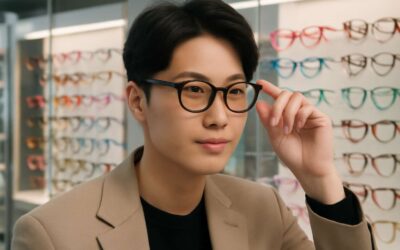Common Causes of Headaches from Prescription Glasses
Incorrect Prescription – How inaccurate prescriptions contribute to headaches
It’s a common tale in the realm of optical mishaps: slipping on a pair of prescription glasses only to find them giving me a headache that lingers longer than a tedious dinner party. The culprit? An incorrect prescription. When your glasses aren’t quite right, your eyes strain to compensate, leading to discomfort that can spiral into throbbing headaches.
Inaccurate prescriptions can distort your vision, forcing your eyes into awkward, unnecessary adjustments. The brain, ever the diligent organiser, struggles to reconcile these conflicting signals, often manifesting as a pounding headache. This phenomenon underscores how vital precise prescriptions are—not just for clear vision but for overall wellbeing.
Often, the source of the problem lies in subtle miscalculations, such as an imprecise sphere or cylinder correction. When these errors occur, they can cause visual fatigue and tension headaches. For those who find that prescription glasses giving me a headache has become a frustrating reality, it’s a clear sign that a re-evaluation with an eye care professional is overdue. After all, your eyes deserve clarity without the pain.
Lens Type and Material Issues – Impact of lens selection on eye strain
In the shadowy corridors of vision, the choice of lens type and material can cast a haunting spell on your eyes. When prescription glasses giving me a headache become an unwelcome companion, the culprit often lurks in the dark corners of lens selection. The wrong material or design can distort light and create unnecessary strain, turning a simple act of reading into a tormenting ordeal.
Many are unaware that the impact of lens material—be it polycarbonate, high-index, or traditional glass—can influence comfort profoundly. Thin, lightweight lenses may seem ideal, but if their optical centre isn’t perfectly aligned, they can become a source of relentless eye strain. Even the lens shape, such as aspheric versus spherical, influences how light enters the eye, potentially aggravating headaches.
For those plagued by the persistent question of prescription glasses giving me a headache, it’s often the unseen details—like lens index or coating—that deepen the darkness of discomfort. Exploring the labyrinth of lens options might just be the key to banishing that relentless ache from your daily vision ritual.
Poor Frame Fit – Effects of ill-fitting glasses on comfort and vision
It is often said that discomfort is the body’s silent protest, and nowhere is this more evident than in the persistent headaches caused by ill-fitting prescription glasses. When prescription glasses giving me a headache become an unwelcome fixture in daily life, the root cause frequently resides in the frame’s fit rather than the lenses themselves. A frame that sits too tightly can exert asymmetric pressure on the temples and nose, disrupting the delicate equilibrium needed for clear, comfortable vision.
Conversely, a loose frame allows movement, forcing the eyes to compensate for shifting lenses — an insidious pathway to eye strain and headaches. The fit isn’t solely about comfort; it influences how light enters your eyes and how well your prescription aligns with your visual axis. For example, improperly balanced temple arms or a poorly adjusted nose pad can cause the lenses to shift subtly, creating visual distortions that intensify fatigue and discomfort.
Ultimately, ensuring your glasses fit precisely is paramount for alleviating the nagging question of prescription glasses giving me a headache. When the frame conforms seamlessly to your face, it supports your vision with stability and comfort, reducing the likelihood of headaches that can sap your focus and energy. Remember, even the most advanced lenses cannot compensate for a poorly fitting frame—an often overlooked aspect of optical health that deserves attention.
Prescription Changes and Adaptation – Adjusting to new prescriptions
Adjusting to a new prescription can feel like stepping into unfamiliar territory—your eyes and brain must forge a new understanding, a delicate dance that often leaves you wearied and headachy. The transition period is fraught with subtle challenges, especially when your eyes struggle to interpret the altered visual signals. This dissonance can manifest as persistent headaches, a silent yet powerful signal that your eyes are fighting to find equilibrium.
Sometimes, this discomfort arises not from the prescription itself but from how your eyes adapt to it. For example, when your new glasses alter your focal points, your visual system needs time to recalibrate. During this process, moments of blurred vision or visual distortion can trigger eye strain — making you question if your prescription glasses are giving me a headache. Recognising the body’s subtle resistance to change is crucial in understanding the deeper layers of visual adaptation.
Signs and Symptoms of Glasses-Related Headaches
Persistent Head Pain – Identifying ongoing discomfort
Persistent headaches can be a frustrating and disruptive experience, especially when they seem to stem from something as seemingly simple as prescription glasses. If you find yourself asking, “Why are my glasses giving me a headache?” it’s important to recognise the signs and symptoms that point to glasses-related discomfort.
One common indicator is ongoing, dull head pain that does not subside after a few hours. This persistent ache often worsens after prolonged wear or intense visual tasks. You might also notice eye strain, neck tension, or a feeling of pressure around your temples. These symptoms can signal that your prescription glasses may not be perfectly suited to your visual needs or that your eyes are struggling to adapt. Recognising these signs early can help you address the root of the problem before it becomes more severe.
Eye Strain and Fatigue – Common indicators of improper glasses
Many people underestimate how significantly improperly fitted or outdated prescription glasses can impact their daily comfort. If you find yourself asking, “Why are my glasses giving me a headache?” it’s often linked to specific signs and symptoms indicating glasses-related discomfort. Eye strain and fatigue are common culprits, especially when your visual system is overstretched or your lenses aren’t optimally suited to your needs.
Persistent eye fatigue might manifest as a burning sensation or a feeling of heaviness behind the eyes. Alongside headaches, you may experience blurred vision or a tendency to squint, which are all signals that your prescription glasses could be causing more harm than good.
- Headaches that worsen after reading or using digital devices
- Discomfort around the temples or behind the eyes
- Difficulty focusing or frequent changes in clarity
Understanding these signs can help identify if prescription glasses giving me a headache is a symptom of underlying issues like incorrect lens strength or poor fit. Recognising the link between eye strain, fatigue, and glasses discomfort underscores the importance of regular eye exams and proper fitting to prevent ongoing visual and physical strain. When your glasses don’t match your visual demands, head pain and eye fatigue become almost inevitable.
Dizziness or Nausea – Unusual symptoms associated with vision correction
It’s startling how often people overlook the subtle signs that their prescription glasses might be causing more harm than benefit. Dizziness and nausea are unusual but telling symptoms that can accompany the familiar headache when wearing ill-fitting or unsuitable glasses. These sensations can disrupt your daily routine and signal an underlying issue with your vision correction.
Uncomfortable head spins or a persistent feeling of queasiness after wearing your glasses should not be dismissed. They often indicate that your prescription isn’t aligned with your current visual needs or that your glasses are contributing to excessive eye strain. If you find yourself asking, “Why are my glasses giving me a headache?” this could be linked to these less obvious but equally disruptive symptoms.
- Feeling dizzy when switching focus between screens and distant objects
- Experiencing nausea after prolonged periods of wearing your glasses
- Difficulty maintaining balance or feeling lightheaded during daily activities
Recognising these signs early can prevent discomfort from escalating. Often, prescription glasses giving me a headache are part of a broader picture that includes dizziness or nausea, which are critical indicators that your eyewear might need adjustment. Regular eye examinations and proper fitting are essential in safeguarding your visual health against these unsettling symptoms.
Blurred Vision and Double Vision – Resolving focus issues
Many individuals are unaware that persistent headaches may stem from more than just stress or fatigue—sometimes, prescription glasses giving me a headache is the silent culprit. When focus becomes an ordeal, blurred vision and double vision often emerge as telltale signs that your eyewear might be misaligned with your visual needs. These issues can subtly sabotage your daily life, causing discomfort that masquerades as mere inconvenience.
Blurred vision can make reading a daunting task, and double vision—seeing two images where only one should be—can be disorienting and frustrating. Such symptoms are not just fleeting annoyances but signals that your glasses may be contributing to your discomfort. Recognising these signs early can make all the difference in preventing long-term eye strain and persistent head pain.
In some cases, adjusting your prescription or switching to lenses better suited to your lifestyle can alleviate these issues. Remember, glasses that do not resolve focus issues can lead to a cascade of problems, including eye fatigue and headaches that feel unrelenting. Paying close attention to these symptoms ensures your visual health remains as luminous as your aspirations.
How to Address Headaches Caused by Prescription Glasses
Getting an Eye Exam and Updating Prescription – Importance of regular eye check-ups
It’s startling how often people dismiss persistent headaches as mere fatigue, when in reality, they could be a sign that “prescription glasses giving me a headache” are afoot. Regular eye exams are your frontline defence against this silent torment. An outdated or inaccurate prescription can cause a cascade of discomfort, subtly straining your eyes with every blink.
Scheduling a comprehensive eye check-up ensures your prescription remains current. During this exam, your optometrist can detect subtle shifts in your vision that might be contributing to headaches. Updating your prescription promptly restores clarity, alleviating undue eye strain and reducing the likelihood of ongoing discomfort.
For those experiencing persistent headaches, a thorough re-evaluation often reveals minor adjustments essential for comfort. Remember, your eyes are unique, and a tailored prescription can make all the difference in eliminating the nagging pain caused by prescription glasses giving me a headache. Don’t let outdated lenses hold you hostage to discomfort—trust regular check-ups to keep your vision sharp and headache-free.
Lens and Frame Adjustments – Ensuring proper fit and function
When prescription glasses give me a headache, it’s often a sign that something is amiss with the fit or alignment of the lenses and frames. Even the slightest misadjustment can turn a daily routine into a source of discomfort. Ensuring proper fit and function is crucial to preventing persistent headaches and eye strain.
One effective approach is to have your glasses professionally adjusted. A well-fitted frame should sit comfortably without pinching or sliding, maintaining the correct position relative to your eyes. If your glasses are too tight, they can cause pressure points, while loose frames may shift, leading to inconsistent vision and headaches.
Consider a comprehensive check-up of your eyewear, focusing on:
- Proper alignment of the lenses with your visual axis
- Correct temple arm length and nose pad positioning
- Ensuring the frames sit level and evenly on your face
Sometimes, even a minor adjustment can make all the difference, transforming your experience from discomfort to clarity. If prescription glasses give me a headache, it’s worth consulting your optometrist or optician to fine-tune your glasses, addressing issues at the root—before they become a persistent problem. Properly adjusted glasses not only enhance visual acuity but also shield you against the nagging pain that can undermine your daily comfort.
Choosing the Right Lens Type – Selecting lenses suitable for your lifestyle
Choosing the right lens type can be the key to alleviating headaches caused by prescription glasses. When your glasses are mismatched to your lifestyle, discomfort is almost inevitable. For instance, if you spend hours on digital devices, selecting lenses with blue light filtering properties can significantly reduce eye strain. Conversely, for outdoor activities, photochromic lenses that adjust to changing light conditions may be ideal, preventing the need for multiple pairs.
It’s essential to consider the material of the lenses as well; lightweight options like polycarbonate or high-index lenses can minimise pressure points and discomfort. Sometimes, simply switching to the correct lens type can transform your experience, turning persistent headaches into clear, comfortable vision. If prescription glasses are giving me a headache, it’s often due to a mismatch in lens selection—highlighting the importance of personalised advice from your optometrist. Remember, the right lenses are an investment in both visual acuity and long-term comfort.
Adaptive Strategies and Eye Exercises – Techniques to reduce strain during adjustment
When the discomfort of prescription glasses giving me a headache persists beyond the initial adjustment phase, it’s often a sign that my eyes are fighting against an unrecognised tension. Adaptive strategies can make all the difference—allowing the eyes to recalibrate and easing that persistent ache. Eye exercises, in particular, serve as a gentle yet powerful tool to reduce strain, fostering a connection between the mind and visual system. Simple techniques like focusing on near and distant objects or blinking consciously can help loosen the rigidity that builds up from prolonged visual fixation.
In some cases, incorporating a routine of eye relaxation techniques—such as palming or gentle eye rolling—can alleviate the discomfort caused by prescription glasses giving me a headache. These methods encourage blood flow and reduce muscular tension around the eyes, creating a more harmonious visual experience. Remember, if your headaches persist, it might be time to revisit your optometrist, as sometimes the root cause lies in subtle misalignments or the need for lens adjustments rather than mere habits. The journey toward clear, comfortable vision is as much about understanding our own responses as it is about the technology behind the lenses.
Preventing Prescription Glasses-Related Headaches
Regular Eye Examinations – Timing and importance
Every flicker of clarity from prescription glasses should feel like a gentle dawn, yet for many, the reality is a persistent ache—prescription glasses giving me a headache becomes an unwelcome companion. The root often lies in the delicate timing of regular eye examinations. Eyes are living, breathing canvases that evolve over time, and an outdated prescription can turn visual harmony into a source of discomfort.
Scheduling routine eye check-ups ensures your prescription remains a true reflection of your current vision needs. During these visits, optometrists can detect subtle shifts and fine-tune your lenses accordingly. This ongoing dialogue with your eye care professional acts as a safeguard against the discomfort caused by ill-fitting or inaccurate prescriptions.
Without this vigilance, even the most stylish frames and high-quality lenses can become a burden—triggering headaches, eye strain, or dizziness. Regular eye examinations are not just appointments; they are vital rituals preserving your visual comfort and preventing the frustrating cycle of prescription glasses giving me a headache.
Proper Frame Selection – Tips for a comfortable fit
There’s nothing quite as frustrating as putting on your prescription glasses and feeling a dull throb behind the eyes—almost as if your spectacles are secretly plotting to take over your head. If prescription glasses giving me a headache sounds all too familiar, the culprit might be your frame choice. Proper frame selection isn’t just about style; it’s about ensuring comfort and clarity. An ill-fitting frame can subtly shift your lenses out of alignment, causing unnecessary eye strain and, ultimately, that nagging headache.
To prevent this discomfort, consider a few simple tips for choosing the right frame. First, ensure the frame fits snugly but comfortably around your face—tight enough to stay in place, but not so tight that it leaves impressions or pinches. The temples should sit comfortably behind your ears without creating pressure points. Additionally, the bridge should sit flush on your nose without slipping or pinching, which can lead to misaligned lenses. Remember, an appropriately sized frame can make all the difference in avoiding the persistent headache caused by ill-fitting glasses.
- Get measured accurately—especially the pupillary distance and bridge width.
- Opt for lightweight materials that won’t cause fatigue during prolonged wear.
- Choose a frame style that complements your facial features and lifestyle.
By prioritising a comfortable fit, you significantly reduce the risk of prescription glasses giving me a headache. After all, your glasses should be a tool for clarity, not a source of misery that turns your visual experience into a headache-inducing ordeal.
Gradual Transition to New Prescriptions – Minimizing discomfort during adjustment
When stepping into the realm of new prescription glasses, patience is a virtue—especially if you’ve experienced prescription glasses giving me a headache. The transition period can feel like navigating uncharted waters, but a gradual adjustment can make all the difference. Rushing into a new prescription without proper acclimatization often exacerbates discomfort, turning what should be a visual upgrade into a headache-inducing ordeal.
To minimise this, consider making incremental changes rather than a sudden leap. For instance, wearing your new glasses for short intervals at first—say, twenty minutes—allows your eyes to adapt gradually. This method is particularly effective if you’re switching to a different lens type or power, which can sometimes throw your visual system into disarray. If headaches persist, revisit your optometrist to ensure your prescription aligns with your needs and that your glasses fit perfectly, reducing the risk of prescription glasses giving me a headache.
Using Proper Eye Care Practices – Maintaining eye health and comfort
In the labyrinth of eye health, even the smallest misstep can turn a simple vision correction into a relentless source of discomfort. Recent studies reveal that nearly 30% of individuals experience some form of eye strain or headache when their prescription glasses are not optimally suited. This is where the magic of proper eye care practices becomes vital. Maintaining eye health and comfort doesn’t merely involve wearing glasses—it requires a delicate balance of habits and awareness.
One of the most effective ways to prevent prescription glasses giving me a headache is to prioritise regular eye examinations. Routine check-ups ensure your prescription remains precise, reducing the likelihood of strain. Additionally, paying attention to your environment—such as proper lighting and screen positioning—can dramatically lessen eye fatigue. Incorporating simple eye exercises, like focusing on distant objects for a few minutes every hour, can also alleviate tension that often leads to headaches.
For those who wear glasses for extended periods, consider using anti-reflective coatings and blue light filters. These features cut down on glare and digital eye strain, common culprits behind persistent headaches. Remember, a comfortable fit is essential; ill-fitting glasses can impose unnatural angles on your vision, exacerbating discomfort. Ultimately, a conscious approach to eye health and proper fitting can make all the difference in preventing prescription glasses giving me a headache, ensuring your visual journey remains clear and headache-free!
When to Consult an Eye Care Professional
Persistent or Severe Headaches – Recognizing serious issues
When the relentless pounding persists, morphing into a searing ache behind the eyes, it is not merely a fleeting discomfort but a siren warning that demands attention. Prescription glasses giving me a headache can be an insidious sign that something is amiss—perhaps an incorrect prescription or a misjudged lens type. Such persistent or severe headaches could signal underlying issues far more serious than simple eye strain, beckoning you to seek professional care without delay.
Ignoring these symptoms might lead to further deterioration of eye health or exacerbate existing conditions. If you experience dizziness, nausea, or blurred vision alongside your headache, it’s crucial to understand that these are not trivial symptoms but urgent indicators of deeper problems. Consulting an eye care professional becomes a vital step—an act of safeguarding your sight and well-being, especially if your prescription glasses are giving me a headache despite wearing them correctly. Recognising the difference between temporary discomfort and warning signs can be the key to preserving your vision’s clarity and comfort in the long run.
Sudden Changes in Vision – Urgent signs that require professional attention
Sudden changes in vision can be a stark warning sign that your eyes are trying to tell you something important. If you notice a sudden loss of clarity, flashes of light, or a shadow creeping across your field of view, it’s time to seek professional help without delay. These symptoms are not only alarming—they can indicate serious underlying issues that require immediate attention. When prescription glasses giving me a headache are accompanied by such abrupt visual shifts, it’s a clear signal that your current prescription might no longer be suitable or that there’s a more urgent problem at hand.
In some cases, these sudden changes may be associated with conditions like retinal detachment or optic nerve problems. Therefore, consulting an eye care professional ensures a thorough assessment and precise diagnosis. Remember, your sight is too precious to risk by ignoring these urgent signs. Prompt intervention can prevent long-term damage and preserve your vision’s clarity and comfort. If you experience these symptoms alongside headaches caused by your prescription glasses giving me a headache, do not hesitate—your eyes deserve swift, expert care.
Discomfort Despite Adjustments – Seeking further evaluation
Sometimes, despite seemingly perfect adjustments, discomfort persists—an unwelcome visitor when you least expect it. If your prescription glasses giving me a headache continue to haunt you, it’s a sign that further evaluation is essential. Persistent pain or unease may indicate that your current prescription isn’t aligning with your eye health or that underlying issues require attention. Ignoring these signals can exacerbate discomfort and lead to more serious complications.
Recognising when to consult an eye care professional is vital. If discomfort lingers or worsens over time, especially alongside symptoms like dizziness or blurred vision, it’s wise to seek expert advice. An eye examination can reveal whether your prescription needs updating or if other factors are contributing to your headaches. Remember, your vision is a precious asset that deserves careful stewardship; don’t let persistent discomfort undermine your clarity or well-being.
- If your headache persists despite wearing your glasses,
- If discomfort worsens after adjustments,
- If visual symptoms such as double vision or nausea accompany the pain,
- If your glasses feel ill-fitting or cause pressure points,
- If you notice any sudden changes in vision or new symptoms,




0 Comments